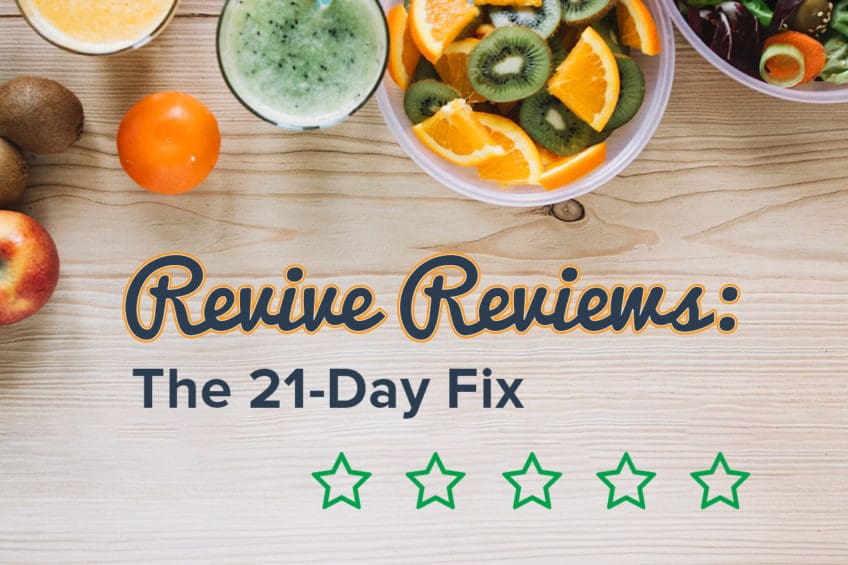The 21-Day Fix Reviewed by a Dietitian
What is the 21-Day Fix?
A diet program centred around portion control using different sized plastic containers. The size of the plastic containers depends on the group or type of food (for example, vegetables, fruit, protein, healthy fats, etc.). Individuals following this program are to use the containers when portioning out their foods for meals and snacks (at home or away from home) and to use a set number of containers for each food per day according to their “plan”. One’s plan (the numbers of each food they are allotted per day) is determined by a simple calculation based solely off weight in pounds.
Free foods are also talked about and can include spices, vinegars, mustard, herbs, tea, coffee, and water. The program also encourages the participant to use Beachbody’s line of supplements, in particular, Energize (for before a workout), Recover (for after a workout), and Shakeology (a meal replacement powder to be used in shakes). “Shakeology Boosts” can be used in combination with Shakeology such as their Focused Energy Boost, Power Greens Boost, and Digestive Health Boost. These supplements are said to help promote faster results and to help maintain results (results being primarily weight loss).
In addition to the 21-Day Fix eating program, Beachbody encourages people to participate in their exercise programs by purchasing a membership to Beachbody On Demand, their online streaming platform that contains all their workout videos.
What are my thoughts on the 21-Day Fix?
What I like about it
Learning portion sizes
One major benefit of following the 21-Day fix is it teaches people how to visualize portions of foods using the coloured plastic containers. It may highlight the fact that serving of vegetables might not be as big as one thinks or that a serving of a fat or oil may be smaller than one thinks. Also, the use of the containers to portion food would likely change the portions of certain foods that people would normally have if they were eye-balling portions; this is likely the source of people’s changes in body composition that can happen.
There are also guides provided in the 21-Day Fix that provide a visual for how meals might look like using the coloured containers. This may provide people with a visualization of how a meal might look like in terms of relative proportions of those foods.
Takes the focus away from calories
Something that commonly happens with the use of food-portioning tools is people tend to let go of the concept of calories coming from food. The supposed idea behind Beachbody’s use of the coloured containers in the 21-Day Fix is that a person will not have to count calories in order to eat properly and see the results they wish to see. This is a positive point that we would encourage here at Revive; counting calories is often unnecessary and can lead to unhealthy obsessions and a skewed relationship with food in general.
What I do not like about it
Anecdotal claims
Many diet and supplement companies will utilize testimonials or anecdotal evidence to support any claims that are made; this program is no exception. Throughout the programs materials and on the website, there are many “before and after” pictures displaying the results of the program. Unfortunately, this is not the same as scientific evidence, which is what should be used to support anything in nutrition. Any company can get a few people (even employees), get them to do a program (with no way to tell if the program was the only variable), take some before and after pictures (often with different poses and lighting), and claim that someone lost X number of pounds in X amount of time.
Focus on weight and appearance as a goal
This point is simple. There is no question the goal of this program is to have someone lose weight or change their physical appearance. Keep in mind the before and after pictures, but also consider Beachbody’s use of a bikini model as their ambassador within the 21-Day Fix materials people get when they sign up. This creates an often-unrealistic view of weight loss and body image for someone, as they look at pictures of the bikini model and automatically think they have to look like that at the end of the program. This can lead to disastrous consequences for some individuals in terms of mental health and body image.
Calorie calculations are inaccurate
As dietitians, we use body composition analysis techniques and various predictive equations to estimate someone’s energy expenditure. Height, age, weight, muscle mass, physical activity level, and gender are taken into account to get the best prediction possible. The 21-Day Fix only uses weight in their equation, putting aside age, gender, and physical activity level. Not only that, I have never seen the equation they use before, so I am not confident it is even researched and validated scientifically.
Plans do not accommodate >2500 kcal
The maximum calorie level accommodated within the 21-Day Fix is 2500 calories. For people who are above this, there is not much direction on how to navigate their individual plans. However, in Beachbody’s defence, the population they deal with probably does not reach these calorie levels too often.
Encourages measuring food all the time
Despite there being a focus away from calorie counting, which is a positive, there is still a focus on measuring food constantly. This is a useful tool for people who may not know what a serving actually looks like, but it is an unnecessary practice for the general population; it is not needed in order to reach the outcome of weight loss. It could lead to unhealthy obsessions with measuring food, contributing to some people’s inability to eat without measuring their food using the coloured containers for fear they would “not be following the program”.
Categories perpetuate confusion about food
When you think of carbohydrates or “carbs”, do you think of pasta, bread, potatoes, rice, and cereal? Those are carbohydrate-containing foods, but so are fruit, vegetables (some more so than others), milk products, and some milk alternatives. The 21-Day Fix puts vegetables, fruit, and carbs in their own categories, which perpetuates the confusion around which foods contain carbohydrates, something we commonly see at our practice.
Nutrient content of food servings within categories
Efforts should be put forth to have indicated servings of any given food within a category set so that they match the other foods in the same category. For example, for “carb foods”, it is logical to standardize the serving sizes so that any food in the list would be X grams of carbohydrates.
Unfortunately, this is not the case for the 21-Day Fix, which creates unnecessary confusion around foods. As an example, listed in the “protein” group is 2 whole eggs (which contains 11.8 grams of protein) and 8 egg whites (which contains 26.4 grams of protein). This could result in people assuming 2 whole eggs have the same amount of protein as 8 egg white, when they clearly do not.
Final Thoughts & Recommendation
Simply put, I would not recommend my clients to follow the 21-Day Fix. While there are positives, I fear that the negative points would lead to confusion and a skewed relationship with food, things that we at Revive are trying to fix. Do not get me wrong, measuring food can be a useful tool, like I talked about before. But it helps when the context in which a person is practicing measuring their food is healthy, which is why working with a registered dietitian first can help straighten things out!
By Brandon Gruber, Registered Dietitian (Nutritionist)
Ready to Ditch the Diet for Good?

